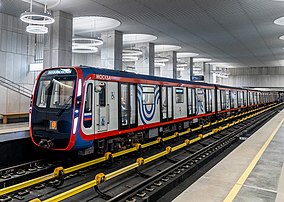Moscow Metro
| Moscow Metro | |||
|---|---|---|---|
 | |||
| Overview | |||
| Native name | Московский метрополитен | ||
| Owner | Government of Moscow | ||
| Area served | Moscow | ||
| Locale | Federal city of Moscow and cities of Kotelniki, Krasnogorsk, Lyubertsy, Reutov in Moscow Oblast, Russia | ||
| Transit type | Rapid transit | ||
| Number of lines | 19 (including the Moscow Monorail and the Moscow Central Circle)[1] | ||
| Number of stations | 294 | ||
| Daily ridership | (average) 7.5 million (highest, 26 Dec 2014) 9.715 million [1] | ||
| Annual ridership | 2.5 billion (2018)[1] | ||
| Chief executive | Viktor Kozlovsky | ||
| Website | mosmetro | ||
| Operation | |||
| Began operation | 15 May 1935 | ||
| Operator(s) | Moskovsky Metropoliten | ||
| Headway | Peak hours: 1.3 - 1.7 mins Off-peak: 2.5 - 10 minutes | ||
| Technical | |||
| System length | 514.5 km (319.7 mi)[1] | ||
| Track gauge | 1,520 mm (4 ft 11+27⁄32 in) | ||
| Electrification | 825 Volt DC third rail, 3 kV DC overhead line | ||
| Average speed | 39.54 km/h (24.57 mph)[1] | ||
| Top speed | 80 km/h (50 mph)[1] | ||
| |||
The Moscow Metro[a] is a metro system serving the Russian capital of Moscow as well as the neighbouring cities of Krasnogorsk, Reutov, Lyubertsy and Kotelniki in Moscow Oblast. Opened in 1935 with one 11-kilometre (6.8 mi) line and 13 stations, it was the first underground railway system in the Soviet Union.
As of 2023[update], the Moscow Metro, excluding the Moscow Central Circle, the Moscow Central Diameters and the Moscow Monorail, had 294 stations and 514.5 km (319.7 mi) of route length, excluding light rail Monorail,[1] making it the 8th-longest in the world and the longest outside China. It is the third metro system in the world (after Madrid and Beijing), which has two ring lines.[2] The system is mostly underground, with the deepest section 84 metres (276 ft) underground at the Park Pobedy station, one of the world's deepest underground stations. It is the busiest metro system in Europe, the busiest in the world outside Asia, and is considered a tourist attraction in itself.[3]
The Moscow Metro is a world leader in the frequency of train traffic—intervals during peak hours do not exceed 90 seconds.[4] In February 2023, Moscow was the first in the world to reduce the intervals of metro trains to 80 seconds.[5]
Name
The full legal name of the metro has been Moscow
The first official name of the metro was L. M. Kaganovich Metro (Метрополитен им. Л.М. Кагановича) after Lazar Kaganovich.[7] (see History section). However, when the Metro was awarded the Order of Lenin, it was officially renamed Moscow Order of Lenin L. M. Kaganovich Metro (Московский ордена Ленина Метрополитен им. Л. М. Кагановича) in 1947. When the metro was renamed in 1955, the Okhotny Ryad station was renamed as "Imeni Kaganovicha" in honor of Lazar Kaganovich. In 1957, the original Okhotny Ryad name of the station was reinstated.[8]
Logo
The first line of the Moscow Metro was launched in 1935, complete with the first logo, the capital M paired with the text "МЕТРО". There is no accurate information about the author of the logo, so it is often attributed to the architects of the first stations – Samuil Kravets, Ivan Taranov and Nadezhda Bykova. At the opening in 1935, the M letter on the logo had no definite shape.[9]
In 2014, the Moscow Metro adopted a standardized logo of the network as part of a broader rebranding of the Moscow Transport.[10]
Operations
The Moscow Metro, a
The Moscow Metro uses 1,520 mm (4 ft 11+27⁄32 in)
The Moscow Metro opens at 05:25 and closes at 01:00.[14] The exact opening time varies at different stations according to the arrival of the first train, but all stations simultaneously close their entrances at 01:00 for maintenance, and so do transfer corridors. The minimum interval between trains is 90 seconds during the morning and evening rush hours.[1]
As of 2017, the system had an average daily ridership of 6.99 million passengers. Peak daily ridership of 9.71 million was recorded on 26 December 2014.[1]
Free Wi-Fi has been available on all lines of the Moscow Metro since 2 December 2014.[15]
Network
This section needs to be updated. (March 2023) |

Lines
Each line is identified by a name, an alphanumeric index (usually consisting of just a number, and sometimes a letter suffix), and a colour.
The metro has a connection to the
| Icon | Line Name | First opened | Latest extension |
Length (km) |
Stations | Avg. dist. | |
|---|---|---|---|---|---|---|---|
| English | Russian | ||||||
| Sokolnicheskaya | Сокольническая | 1935 | 2019 | 41.5 | 26 | 1.6 | |
| Zamoskvoretskaya | Замоскворецкая | 1938 | 2018 | 42.8 | 24 | 1.86 | |
| Arbatsko-Pokrovskaya | Арбатско-Покровская | 1938 | 2012 | 45.1 | 22 | 2.15 | |
| Filyovskaya | Филёвская | 1958 (1935)[Note 1] | 2006 | 14.9 | 13 | 1.24 | |
| Koltsevaya (Circle) | Кольцевая | 1950 | 1954 | 19.3 | 12 | 1.61 | |
| Kaluzhsko-Rizhskaya | Калужско-Рижская | 1958 | 1990 | 37.8 | 24 | 1.63 | |
| Tagansko-Krasnopresnenskaya | Таганско-Краснопресненская | 1966 | 2015 | 42.2 | 23 | 1.92 | |
| Kalininskaya[Note 2] | Калининская | 1979 | 2012 | 16.3 | 8 | 2.36 | |
| Solntsevskaya[Note 2] | Солнцевская | 2014 | 2023 | 28.3 | 14 | 2.02 | |
| Serpukhovsko-Timiryazevskaya | Серпуховско-Тимирязевская | 1983 | 2002 | 41.5 | 25 | 1.72 | |
| Lyublinsko-Dmitrovskaya | Люблинско-Дмитровская | 1995 | 2023 | 44.3 | 26 | 1.77 | |
| Bolshaya Koltsevaya (Big Circle) | Большая кольцевая | 2018 | 2023 | 61.7 | 31 | 1.99 | |
| Butovskaya | Бутовская | 2003 | 2014 | 10.0 | 7 | 1.67 | |
| Moscow Central Circle[Note 3] | Московское центральное кольцо | 2016 | 2016 | 54.0 | 31 | 1.74 | |
| Nekrasovskaya | Некрасовская | 2019 | 2020 | 14.0 | 8 | 1.75 | |
| Total | 514.5 | 294 | 1.75 | ||||
| Light rail | |||||||
| Monorail[Note 4] | Монорельс | 2004 | 2004 | 4.7 | 6 | 0.94 | |
| Other urban rail lines [Note 5] | |||||||
| Line D1 (Moscow Central Diameters) | Белорусско-Савёловский диаметр | 2019 | 2020 | 52 | 25 | 2.08 | |
| Line D2 (Moscow Central Diameters) | Курско-Рижский диаметр | 2019 | 2023 | 80 | 37 | 2.16 | |
| Line D3 (Moscow Central Diameters) | Leningradskoe - Kazanskiy диаметр | 2023 | 2023 | 85 | 38 | 2.24 | |
| Line D4 (Moscow Central Diameters) | Kaluzhsko-Nizhegorodsky диаметр | 2023 | 2023 | 86 | 36 | 2.39 | |
| Total | 822.2 | 436 | 1.89 | ||||
| |||||||
Also, from 11 August 1969 to 26 October 2019, the Moscow Metro included Kakhovskaya line 3.3 km long with 3 stations, which closed for a long reconstruction. On 7 December 2021, Kakhovskaya is reopened after reconstruction as part of the Bolshaya Koltsevaya line. The renewed Varshavskaya and Kashirskaya stations reopened as part of the Bolshaya Koltsevaya line, which became fully functional on 1 March 2023. Its new stations included Pechatniki, Nagatinsky Zaton and Klenovy Bulvar.[17]
Renamed lines
- Sokolnicheskaya line was previously named Kirovsko-Fruzenskaya
- Zamoskvoretskaya line was previously named Gorkovsko-Zamoskvoretskaya.
- Filyovskaya line was previously named Arbatsko-Filyovskaya.
- Tagansko-Krasnopresnenskaya line was previously named Zhdanovsko-Krasnopresnenskaya
History
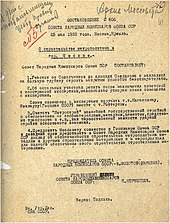

The first plans for a metro system in Moscow date back to the Russian Empire but were postponed by World War I, the October Revolution and the Russian Civil War. In 1923, the Moscow City Council formed the Underground Railway Design Office at the Moscow Board of Urban Railways. It carried out preliminary studies, and by 1928 had developed a project for the first route from Sokolniki to the city centre. At the same time, an offer was made to the German company Siemens Bauunion to submit its own project for the same route. In June 1931, the decision to begin construction of the Moscow Metro was made by the Central Committee of the Communist Party of the Soviet Union. In January 1932 the plan for the first lines was approved, and on 21 March 1933 the Soviet government approved a plan for 10 lines with a total route length of 80 km (50 mi).
The first lines were built using the Moscow general plan designed by
Soviet workers did the labour and the art work, but the main engineering designs, routes, and construction plans were handled by specialists recruited from London Underground. The British called for tunnelling instead of the "
First four stages of construction
The first line was opened to the public on 15 May 1935 at 07:00 am.[23] It was 11 kilometres (6.8 mi) long and included 13 stations. The day was celebrated as a technological and ideological victory for socialism (and, by extension, Stalinism). An estimated 285,000 people rode the Metro at its debut, and its design was greeted with pride; street celebrations included parades, plays and concerts. The Bolshoi Theatre presented a choral performance by 2,200 Metro workers; 55,000 colored posters (lauding the Metro as the busiest and fastest in the world) and 25,000 copies of "Songs of the Joyous Metro Conquerors" were distributed.[24] The Moscow Metro averaged 47 km/h (29 mph) and had a top speed of 80 km/h (50 mph).[25] In comparison, New York City Subway trains averaged a slower 25 miles per hour (40 km/h) and had a top speed of 45 miles per hour (72 km/h).[24] While the celebration was an expression of popular joy it was also an effective propaganda display, legitimizing the Metro and declaring it a success.
The initial line connected
The second stage was completed before the
Building work on the third stage was delayed (but not interrupted) during
After the war ended in 1945, construction began on the fourth stage of the Metro, which included the
Stalinist ideals in Metro's history
| External videos | |
|---|---|
When the Metro opened in 1935, it immediately became the centrepiece of the transportation system (as opposed to horse-carried barrows still widely used in 1930s Moscow). It also became the prototype, the vision for future Soviet large-scale technologies. The artwork of the 13 original stations became nationally and internationally famous. For example, the
The Metro was also iconic for showcasing
- Kaganovich was in charge; he designed the subway so that citizens would absorb the values and ethos of Stalinist civilization as they rode. Without this cohesion, the Metro would not reflect Socialist Realism. If the Metro did not utilize Socialist Realism, it would fail to illustrate Stalinist values and transform Soviet citizens into socialists. Anything less than Socialist Realism's grand artistic complexity would fail to inspire a long-lasting, nationalistic attachment to Stalin's new society.[29]
- Socialist Realism was in fact a method, not exactly a style.[30]
Bright future and literal brightness in the Metro of Moscow
The Moscow Metro was one of the USSR's most ambitious architectural projects. The metro's artists and architects worked to design a structure that embodied svet (literally "light", figuratively "radiance" or "brilliance") and svetloe budushchee (a well-lit/radiant/bright future).[30] With their reflective marble walls, high ceilings and grand chandeliers, many Moscow Metro stations have been likened to an "artificial underground sun".[31]
This palatial underground environment[31] reminded Metro users their taxes were spent on materializing bright future; also, the design was useful for demonstrating the extra structural strength of the underground works (as in Metro doubling as bunkers, bomb shelters).
The chief lighting engineer was Abram Damsky, a graduate of the Higher State Art-Technical Institute in Moscow. By 1930 he was a chief designer in Moscow's Elektrosvet Factory, and during World War II was sent to the Metrostroi (Metro Construction) Factory as head of the lighting shop.[32] Damsky recognized the importance of efficiency, as well as the potential for light as an expressive form. His team experimented with different materials (most often cast bronze, aluminum, sheet brass, steel, and milk glass) and methods to optimize the technology.[32] Damsky's discourse on "Lamps and Architecture 1930–1950" describes in detail the epic chandeliers installed in the Taganskaya Station and the Kaluzhskaia station (Oktyabrskaya nowadays, not to be confused with contemporary "Kaluzhskaya" station on line 6). The work of Abram Damsky further publicized these ideas hoping people would associate the party with the idea of bright future.
The Kaluzhskaya Station was designed by the architect [Leonid] Poliakov. Poliakov's decision to base his design on a reinterpretation of Russian classical architecture clearly influenced the concept of the lamps, some of which I planned in collaboration with the architect himself. The shape of the lamps was a torch – the torch of victory, as Polyakov put it... The artistic quality and stylistic unity of all the lamps throughout the station's interior made them perhaps the most successful element of the architectural composition. All were made of cast aluminum decorated in a black and gold anodized coating, a technique which the Metrostroi factory had only just mastered.
The Taganskaia Metro Station on the Ring Line was designed in...quite another style by the architects K.S. Ryzhkov and A. Medvedev... Their subject matter dealt with images of war and victory...The overall effect was one of ceremony ... In the platform halls the blue ceramic bodies of the chandeliers played a more modest role, but still emphasised the overall expressiveness of the lamp.[32]
— Abram Damsky, Lamps and Architecture 1930–1950
Industrialization


Stalin's first five-year plan (1928–1932) facilitated rapid industrialization to build a socialist motherland. The plan was ambitious, seeking to reorient an agrarian society towards industrialism. It was Stalin's fanatical energy, large-scale planning, and resource distribution that kept up the pace of industrialization. The first five-year plan was instrumental in the completion of the Moscow Metro; without industrialization, the Soviet Union would not have had the raw materials necessary for the project. For example, steel was a main component of many subway stations. Before industrialization, it would have been impossible for the Soviet Union to produce enough steel to incorporate it into the metro's design; in addition, a steel shortage would have limited the size of the subway system and its technological advancement.
The Moscow Metro furthered the construction of a socialist Soviet Union because the project accorded with Stalin's second five-year plan. The Second Plan focused on urbanization and the development of social services. The Moscow Metro was necessary to cope with the influx of peasants who migrated to the city during the 1930s; Moscow's population had grown from 2.16 million in 1928 to 3.6 million in 1933. The Metro also bolstered Moscow's shaky infrastructure and its communal services, which hitherto were nearly nonexistent.[24]
Mobilization
The Communist Party had the power to mobilize; because the party was a single source of control, it could focus its resources. The most notable example of mobilization in the Soviet Union occurred during World War II. The country also mobilized in order to complete the Moscow Metro with unprecedented speed. One of the main motivation factors of the mobilization was to overtake the West and prove that a socialist metro could surpass capitalist designs. It was especially important to the Soviet Union that socialism succeed industrially, technologically, and artistically in the 1930s, since capitalism was at a low ebb during the Great Depression.
The person in charge of Metro mobilization was
This was a comprehensive mobilization; the project drew resources and workers from the entire Soviet Union. In his article, archeologist Mike O'Mahoney describes the scope of the Metro mobilization:
A specialist workforce had been drawn from many different regions, including miners from the Ukrainian and Siberian coalfields and construction workers from the iron and steel mills of Magnitogorsk, the Dniepr hydroelectric power station, and the Turkestan-Siberian railway... materials used in the construction of the metro included iron from Siberian Kuznetsk, timber from northern Russia, cement from the Volga region and the northern Caucasus, bitumen from Baku, and marble and granite from quarries in Karelia, the Crimea, the Caucasus, the Urals, and the Soviet Far East
— Mike O'Mahoney, Archeological Fantasies: Constructing History on the Moscow Metro[33]
Skilled engineers were scarce, and unskilled workers were instrumental to the realization of the metro. The Metrostroi (the organization responsible for the Metro's construction) conducted massive recruitment campaigns. It printed 15,000 copies of Udarnik metrostroia (Metrostroi Shock Worker, its daily newspaper) and 700 other newsletters (some in different languages) to attract unskilled laborers. Kaganovich was closely involved in the recruitment campaign, targeting the Komsomol generation because of its strength and youth.
Later Soviet stations
"Fifth stage" set of stations
The beginning of the
In the further development of the Metro the term "stages" was not used any more, although sometimes the stations opened in 1957–1959 are referred to as the "fifth stage".
Nikita Khrushchev's era of cost cutting
During the late 1950s and throughout the 1960s, the architectural extravagance of new Metro stations was decisively rejected on the orders of
A typical layout of the cheap shallow-dug metro station (which quickly became known as Sorokonozhka – "centipede", from early designs with 40 concrete columns in two rows) was developed for all new stations, and the stations were built to look almost identical, differing from each other only in colours of the marble and ceramic tiles. Most stations were built with simpler, cheap technology; this resulted in utilitarian design being flawed in some ways. Some stations such as adjacent Rechnoi Vokzal and Vodny Stadion or sequiential Leninsky Prospect, Akadmicheskaya, Profsoyuznaya and Novye Cheryomushki would have a similar look due to the extensive use of same-sized white or off-white ceramic tiles with hard-to-feel differences.
Walls with cheap ceramic tiles were susceptible to train-related vibration: some tiles would eventually fall off and break. It was not always possible to replace the missing tiles with the ones of the exact color and tone, which eventually led to variegated parts of the walls.
Metro stations of late USSR
The contrasting style gap between the powerfully decorated stations of Moscow's center and the spartan-looking stations of the 1960s was eventually filled. In the mid-1970s the architectural extravagance was partially restored. However, the newer design of shallow "centipede" stations (now with 26 columns, more widely spaced) continued to dominate. For example, Kaluzhskaya "centipede" station from 1974 (adjacent to Novye Cheryomushki station) features non-flat tiles (with 3D effect utilized), and Medvedkovo from 1978 features complex decorations.
1971 station Kitay-Gorod ("Ploshchad Nogina" at the time) features cross-platform interchange (Line 6 and line 7). Although built without "centipede" design or cheap ceramic tiles, the station utilizes near-grayscale selection of colors. It is to note the "southbound" and "northbound" halls of the station have identical look.
Downtown area got such stations as
Post-USSR stations of the modern Russian Federation


Metro stations of the 1990s and 2000s vary in style, but some of the stations seem to have their own themes:
- Ulitsa Akademika Yangelya station used to feature thick orange neon lamp-like sodium lights instead of regular white lights.
- Park Pobedy, the deepest station of the Moscow Metro, was built in 2003; it features extensive use of dark orange polished granite.
- Slavyansky Bulvar station utilizes a plant-inspired theme (similar to "bionic style").
- The sleek variant of aforementioned bionic style is somewhat represented in various Line 10 stations.
- Sretensky Bulvar station of line 10 is decorated with paintings of nearby memorials and locations.
- Strogino station has a theme of huge eye-shaped boundaries for lights; with "eyes" occupying the station's ceiling.
- Troparyovo (2014) features trees made of polished metal. The trees hold the station's diamond-shaped lights. The station, however, is noticeably dim-lit.
- Delovoy Tsentr (2016, MCC, overground station) has green tint.
- Lomonosovsky Prospekt (Line 8A) is decorated with various equations.
- Olkhovaya (2019) uses other plant-inspired themes (ольха noun means alder) with autumn/winter inspired colours.
- Kosino (2019) uses high-tech style with the addition of thin LED lights.
Some bleak, bland-looking "centipedes" like Akademicheskaya and Yugo-Zapadnaya have undergone renovations in the 21st century (new blue-striped white walls on Akademicheskaya, aqualine glassy, shiny walls on Yugo-Zapadnaya).
Moscow Central Circle urban railway (Line 14)

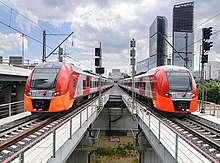

A new circle metro line in Moscow was relatively quickly made in the 2010s. The Moscow Central Circle line (Line 14) was opened for use in September 2016 by re-purposing and upgrading the Maloe ZheleznoDorozhnoe Kol'tso. A proposal to convert that freight line into a metropolitan railway with frequent passenger service was announced in 2012. The original tracks had been built in pre-revolutionary Moscow decades before the creation of Moscow Metro; the tracks remained in place in one piece as a non-electrified line until the 21st century. Yet the circle route was never abandoned or cut. New track (along the existing one) was laid and all-new stations were built between 2014 and 2016. MCC's stations got such amenities as vending machines and free water closets.
Line 14 is operated by
There is a noticeable relief of congestion, decrease in usage of formerly overcrowded Koltsevaya line since the introduction of MCC. To make line 14 attractive to frequent Koltsevaya line interchanges users, upgrades over regular comfort of Moscow Metro were made. Use of small laptops/portable video playing devices and food consumption from tupperwares and tubs was also improved for Line 14: the trains have small folding tables in the back of nearly every seat, while the seats are facing one direction like in planes or intercity buses - unlike side-against-side sofas typical for Metro.
Unlike MCD lines (D1, D2 etc.) MCC line accepts "unified" tickets and "Troika" cards just like Moscow Metro and buses of Moscow do. Free transfers are permitted between the MCC and the Moscow Metro if the trip before the transfer is less than 90 minutes.[34] It's made possible by using same "Ediny", literally "unified" tickets instead of printing "paper tickets" used at railroads.
- To interchange to line 14 for free, passenger must keep their freshly used ticket after entering Moscow Metro to apply it upon entering any line 14 station (and vice versa, keep their "fresh" ticket to enter underground Metro line after leaving Line 14 for an interchange).
MCD (D lines)
In 2019, new lines of
As for the fees, MCD accepts Moscow's "Troika" cards. Also, every MCD station has printers which print "station X – station Y" tickets on paper. Users of the D lines must keep their tickets until exiting their destination stations: their exit terminals require a valid "... to station Y" ticket's barcode.[citation needed]
Big Circle Line (line 11)
After upgrading the railway from 1908 to a proper Metro line, the development of another circle route was re-launched, now adjusted for the pear-shaped circle route of line #14.
Throughout the late 2010s, Line 11 was extended from short, tiny Kakhovskaya line to a half-circle (from Kakhovskaya to Savyolovskaya). In early 2023, the circle was finished.[36]
- Similarly made Shelepikha, Khoroshovskaya, CSKA and Petrovsky Park stations have lots of polished granite and shiny surfaces, in contrast to Soviet "centipedes". Throughout 2018–2021, these stations were connected to line 8A.
- Narodnoye Opolcheniye (2021) features lots of straight edges and linear decorations (such as uninterrupted "three stripes" style of the ceiling lights and rectangular columns).
As for the spring of 2023, the whole circle route line is up and running, forming a circle stretching to the southern near-MKAD residential parts of the city (Prospekt Vernadskogo, Tekstilshchiki) as opposed to the MCC's stretching towards the northern districts of Moscow. In other words, BCL "mirrors" MCC, avoiding forming a perfect circle around the city centre. While being 70 km long, the line is now the longest subway line in the world, 13 kilometres ahead of the previous record holder - the line 10 of Beijing Subway.[37]
Expansions
Graphs are unavailable due to technical issues. There is more info on Phabricator and on MediaWiki.org. |

Since the turn of the 2nd millennium several projects have been completed, and more are underway. The first was the Annino-Butovo extension, which extended the
The
After many years of construction, the long-awaited
In 2011, works began on the
In 2013, the
Current plans
In addition to major metro expansion the Moscow Government and Russian Railways plans to upgrade more commuter railways to a metro-style service, similar to the MCC. New tracks and stations are planned to be built in order to achieve this.
| Line | Terminals | Length (km) | Stations | Status | Planned opening | |
|---|---|---|---|---|---|---|
| Novatorskaya | Kommunarka | 19 | 7 | Under construction | 2024 | |
| Kommunarka | Potapovo | 2.4 | 1 | Under construction | 2024 | |
| Novatorskaya | ZIL | 8.5 | 4 | Under construction | 2024 | |
| Shelepikha | Bulvar Karbysheva | 3.7 | 3 | Under construction | 2026-2027 | |
| Suvorovskaya | 0 | 1 | Under construction | 2028 | ||
| ZIL | Biryulyovo | 22.2 | 10 | Under Construction | 2026+ | |
| Yuzhny Port | 0 | 1 | Planned | 2027 | ||
| Shchyolkovskaya | Golyanovo
|
1.5 | 1 | Planned | 2027 | |
| Kommunarka | Troitsk | 6 | Planned | 2028-2029 | ||
| Bulvar Karbysheva | Ilyinskaya | 5 | Planned | 2028-2029 | ||
Kalininskaya line
|
Tretyakovskaya | Delovoy Tsentr | 5.1 | 3 | Planned | |
Stations
Of the metro's 250 stations, 88 are deep underground, 123 are shallow, 12 are surface-level and 5 are elevated.
This section needs to be updated. (January 2018) |
The deep stations comprise 55
The stations being constructed under
The stations opened in the 21st century are influenced by an international and more neutral style with improved technical quality.[41]
-
Ploshchad Revolyutsii (1938)
-
Baumanskaya (1944)
-
Novoslobodskaya (1952)
-
Leninsky Prospekt (1962)
-
Kakhovskaya (1969) (after 2021 reconstruction)
-
Tretyakovskaya (early station, 1971)
-
Shabolovskaya (1980)
-
Tretyakovskaya (additional adjacent station, 1986)
-
Konkovo (1987)
-
Tyoply Stan (1987)
-
Rimskaya (1995)
-
Park Pobedy (2003)
-
Slavyansky Bulvar (2008)
-
Novokosino (2012)
-
Kosino (2019)
Rolling stock
Since the beginning,
Trains on the Zamoskvoretskaya,
Dimensions have varied subtly, but for the most cars fit into the ranges of 19–20 metres (62 ft 4 in – 65 ft 7 in) long and 2.65–2.7 metres (8 ft 8+3⁄8 in – 8 ft 10+1⁄4 in) wide with 4 doors per side. The 81-740/741 Rusich deviates greatly from this, with a 3-car Rusich being roughly 4 normal cars and a 5-car Rusich being 7 normal cars.
| Car | Delivered | In service |
|---|---|---|
| А/Б ("A/B") | 1934–1939 | 1935–1975 |
| B ("V", earlier C) | 1927–1930 | 1946–1968 |
| Г ("G") | 1939–1940, 1946–1956 | 1940–1983 |
| Д ("D") | 1955–1963 | 1955–1995 |
| E/Ем/Еж ("E/Em/Ezh") | 1959–1979 | 1962–2020 |
| 81-717/81-714 | 1976–2011 | 1977 ff. |
| И ("I", 81-715/716) | 1974, 1980–1981, 1985 | — |
| 81-720/721 "Yauza" | 1991–2004 | 1998–2019 |
| 81-740/741 "Rusich" | 2002–2013 | 2003 ff. |
| 81-760/761 "Oka" | 2010–2016 | 2012 ff. |
81-765/766/767 "Moskva" |
2016–2020 | 2017 ff. |
81-775/776/777 "Moskva 2020" |
2020 ff. | 2020 ff. |
Trains no longer in operation
The V-type trains were formerly from Berlin U-Bahn C-class trains from 1945 to 1969, until its complete demise in 1970. They were transported from the Berlin U-Bahn during the Soviet occupation. A-type and B-type trains were custom-made since the opening.
-
A-type
-
B-type
-
V-4-type (former Berlin Class C-1)
-
V2-type (former Berlin Class C-2)
-
G-type
-
D-type
-
E-type
-
I-1-type (81-715.1/716.1)
-
I-2-type (81-715.2/716.2)
Trains in operation
Currently, the Metro only operates 81-style trains.
Rolling stock on several lines was replaced with articulated 81-740/741 Rusich trains, which were originally designed for light rail subway lines. The
On the Moscow Monorail, Intamin P30 trains are used, consisting of six short cars. On the Moscow Central Circle, which is a route on the conventional railway line, ES2G Lastochka trains are used, consisting of five cars.
-
81-717.5A/81-714.5A-type ("retro train")
-
81-717.6-714.6-type
-
81-775/776/777-type ("Moscow-2020")
-
Intamin P30 train (operates on the Monorail line)
-
ES2G Lastochka train (operates on the Moscow Central Circle line)
Ticketing


The Moscow Metro charges a flat fare for a single journey, regardless of distance or time travelled within the network. An exception to this is the Moscow Central Diameters, which operate on a zone-based fare system. The Moscow Metro ticketing system allows free interchanges within a 90-minute window between different transport modes, including the MCC, the MCD, trams and buses.[42]
Modern Metro turnstiles are designed to accept various forms of payment, including plastic cards like the Troika card or Moscow Resident Social Cards, bank cards, bank stickers, souvenir tickets such as Troika rings, bracelets, or keychains, and disposable RFID chip cardboard cards. Additionally, all stations are equipped to accept biometric payments. Some transport cards have usage limitations that impose a waiting period between consecutive uses (e.g., delays of 7 or 20 minutes).[43]
History of the ticketing system
Soviet era turnstiles simply accepted N kopeck coins.
In the early years of Russian Federation (and with the start of a
On 1 September 1998, the Moscow Metro became the first metro system in Europe to fully implement "contactless"
In August 2004, the
Since 2006,
In January 2007, Moscow Metro began replacing limited magnetic cards with contactless disposable tickets based on NXP's MIFARE Ultralight technology. Ultralight tickets are available for a fixed number of trips in 1, 2, 5, 10, 20 and 60-trip denominations (valid for 5 or 90 days from the day of purchase) and as a monthly ticket, only valid for a selected calendar month and limited to 70 trips. The sale of magnetic cards ended on 16 January 2008 and magnetic cards ceased to be accepted in late 2008, making the Moscow metro the world's first major public-transport system to run exclusively on a contactless automatic fare-collection system.[46]
Contemporary ticketing system
On 2 April 2013, the Moscow Department of Transport introduced the Troika smartcard, which serves as the foundation of the city's modern ticketing system. Currently, passengers can use a single Troika card to pay for travel on the metro, MCC, MCD, buses, trams, river transport, suburban trains, and Aeroexpress. Approximately 80% of all trips in Moscow are paid for using Troika, with over 50 million cards sold to date.[47]
In 2023, Troika production, including its chip, was fully localized in Moscow. In 2024, Moscow plans to launch a virtual analog of the card for smartphones.[48]
Moreover, the Moscow Metro offers Ediniy (Unified) tickets with varying durations: 1 day, 3 days, 30 days, 60 days, 90 days and 365 days.[49]
In 2015, the Moscow Metro started testing bank card payments at ticket windows.[50] At the moment, bank card or bank sticker payments are accepted at all turnstiles in the network. As of April 2024, this payment option is used approximately 900 thousand times daily.[51]
In October 2021, the Moscow Metro became the first metro system in the world to implement biometric payment on a large scale. To use this system, passengers must link their photo, bank card, and metro card to the service through the Moscow Metro mobile app. This allows passengers to pay for their rides without taking out their phone, metro card, or bank card, thereby increasing passenger flow at station entrances. The technology is available at all metro stations, the MCC, and on river transport. As of April 2024, passengers have completed 100 million trips using biometric technology.[52]
Other payment methods include:
- Payment via Mir Pay using an Android phone with a Mir card
- Payment with a smartphone via FPS in open test mode at all metro, MCC, and river transport turnstiles
- Cash or bank card payments at ticket offices and vending machines
- Moscow Resident Social Card
The Moscow Metro ticketing system received two prestigious international Transport Ticketing Awards in 2020[53] and 2021.[54]
Fares
| Trip limit | Cost for central zone | Cost for suburban zone |
|---|---|---|
| Ediny ticket. Valid for metro, monorail, MCC and ground transport. Not valid for MCD. | ||
| 1 ride | 62 | - |
| 2 rides | 124 | - |
| Koshelek ticket on the Troika card. Valid for all public transport in Moscow (Metro, MCC, all surface transport, suburban electric trains). | ||
| 1 ride | 50 | 65 |
| 90 minutes | 75 | - |
| Ediny ticket on the Troika card. Valid for all metro, monorail, MCC, MCD zones "Central", "Suburban" or land transport. | ||
| 60 trips | 2.730 | – |
| 1 day | 285 | – |
| 3 nights | 540 | – |
| 30 days | 2.540 | 3.010 |
| 90 days | 6.150 | 7.800 |
| 365 days | 19.500 | 24.450 |
MCD network is divided between the "Central" and "Suburban" zone. Metro (with the monorail and the MCC) is completely within the Central zone.
| Effective date | Price | Remarks |
|---|---|---|
| 1935-05-15 | 50 kopecks | |
| 1935-08-01 | 40 kopecks | with season ticket – 35 kopecks |
| 1935-10-01 | 30 kopecks | with season ticket – 25 kopecks |
| 1942-05-31 | 40 kopecks | |
| 1948-08-16 | 50 kopecks | Banknotes were cut in value to one-tenth but most prices stayed the same |
| 1961-01-01 | 5 kopecks | redenomination; turnstiles accepted 5 kopek coins |
| 1991-04-02 | 15 kopecks | Turnstiles accepted three 5 kopeck coins (written 5+5+5) |
| 1992-03-01 | 50 kopecks | 5 kopeck coins were replaced by turnstile tokens |
| 1992-06-24 | 1 ruble | |
| 1992-12-01 | 3 rubles | |
| 1993-02-16 | 6 rubles | |
| 1993-06-25 | 10 rubles | |
| 1993-10-15 | 30 rubles | |
| 1994-01-01 | 50 rubles | |
| 1994-03-18 | 100 rubles | |
| 1994-06-23 | 150 rubles | |
| 1994-09-21 | 250 rubles | |
| 1994-12-20 | 400 rubles | |
| 1995-03-20 | 600 rubles | |
| 1995-07-21 | 800 rubles | |
| 1995-09-20 | 1,000 rubles | |
| 1995-12-21 | 1,500 rubles | |
| 1997-06-11 | 2,000 rubles | |
| 1998-01-01 | 2 rubles | Redenomination due to post-Soviet inflation |
| 1998-09-01 | 3 rubles | |
| 1999-01-01 | 4 rubles | |
| 2000-07-15 | 5 rubles | |
| 2002-10-01 | 7 rubles | |
| 2004-04-01 | 10 rubles | |
| 2005-01-01 | 13 rubles | Monorail fare is 50 rubles (25 rubles discount fare), no other tickets are valid on monorail |
| 2006-01-01 | 15 rubles | |
| 2007-01-01 | 17 rubles | |
| 2008-01-01 | 19 rubles | Monorail fare is equal to the metro fare (reduced to 19 rubles), and only special monthly tickets also available and valid on this line |
| 2009-01-01 | 22 rubles | |
| 2010-01-01 | 26 rubles | |
| 2011-01-01 | 28 rubles | Russian Railways fare in Moscow fare principles are separated and the fare did not increase (26 rubles) unlike in earlier years. |
| 2013-01-01 | 28 rubles | minor change: Monorail fare included in all metro fares, first transfer in 90 minutes does not charge |
| 2013-04-02 | 30 rubles | Single journey fare increased. Most other kinds of fares are lowered. New: 90 minute fare. |
| 2014-01-01 | 30–40 rubles | Single and double fare increased. 5–60 pass fare, and all 90 minute fare are stayed. Russian railway fare in Moscow increased to 28 rubles. |
| 2016-01-01 | 32–50 rubles | All ticket fares increased. Single fare increased to 50 rubles or 32 rubles (by Troika e-wallet). All unlimited fare are stayed.[55] |
| 2017-01-01 | 35–55 rubles | All ticket fares increased. Single fare increased to 55 rubles or 35 rubles (by Troika e-wallet). All |-unlimited fare are stayed. |
| 2018-01-02 | 36–55 rubles | Single fare increased by 1 ruble, only while paying by Troika e-wallet. 90 minutes fare increased from 54 to 56 rubles. |
| 2019-01-02 | 38–55 rubles | Single fare increased by 2 rubles, while paying Troika card. 90 minutes tickets increased by 3 rubles. |
| 2019-12-09 | 38–55 rubles | 4 of 10 railway lines included in metro fare; central zone does not require (0–2 zones), surburbian +7RUR (but 7 RUR is difference only, 2–3 zones cost 23 RUR as earlier) |
| 2020-02-01 | 40–57 rubles | fares increased by 2 rubles, season tickets stayed. Also opened Ostafievo in zone 5 that caused to lower some fares is you set as destation and course of another ticket |
| 2020-04-21 | 40 rubles | Till 2010-06-09 COVID-19 restriction: single fare tickets are eliminated, bank cards disabled till June 9, some discount ticked also blocked (dates non shown) |
| 2020-02-01 | 42–60 rubles | fares raised except 90/365 days |
Passenger services
Passenger Mobility Center
The Passenger Mobility Center was created within the Moscow Metro in October 2013 to aid passengers with reduced mobility, encompassing individuals with hearing or visual impairments, mobility limitations, senior citizens, large families, and parents with strollers.[56] Today, the PMC staff escorts passengers at the metro, MCC, MCD, buses and trams.
Since its inception, PMC has assisted over 1.15 million passengers with reduced mobility.[57] In 2023, PMC staff escorted approximately 70,000 passengers, representing a 9% increase compared to 2022.[56]
Wayfinding
In 2013, the Moscow Metro started to develop the new principles of wayfinding, including a redesigned metro map. Today, these principles have been applied to all of Moscow Transport. The new system is characterized by the following features:
- The single font of the Moscow Transport – Moscow Sans
- More concise and comprehensible signage
- Geographical maps across the city that includes information on surrounding streets and landmarks
- Use of easily understandable pictograms instead of words (e.g., line numbers)
- Assignment of numbers to each metro exit
- Floor signage on stations
- Accessibility information for passengers with reduced mobility
- Digital wayfinding screens above the doors in the newest train models
- A standardized design for temporary announcements[58]
Digital services
Mobile app
Launched in 2017, the Moscow Metro mobile app offers a range of useful features for passengers:
- Troika card management (purchase tickets, view pass and transaction history, set up auto-payment)
- Transfer of Troika card balance to a new card in case of loss
- Identification of less crowded carriages on arriving trains
- Temporary suspension of annual passes (once per year for 14 days)
- Route planning
- Linking of the Moscow Resident Social Card
- Purchase of intercity bus tickets
- Registration for biometric payment service
- Reporting of lost items
- Request for assistance from the Passenger Mobility Service
- Chatbot access
As of March 2024, the app has been downloaded 13 million times and is used by 2 million people monthly.[59]
Chatbot
In 2020, the Moscow Metro introduced Aleksandra, a chatbot that has since become the official chatbot for all types of urban transport in Moscow. As of February 2024, Aleksandra has answered over 6.8 million questions and is equipped to respond to over 58,000 inquiries related to Moscow's urban transport system.[60]
Statistics
This section needs to be updated. (January 2018) |
| Ridership statistics | |
|---|---|
| Passengers (2018) | 2,500,400,000 passengers[1] |
| —— full-fare | 1,812,900,000 passengers |
| —— privileged category | 473,500,000 passengers |
| —— pupils and students | 214,000,000 passengers |
| Maximum daily ridership | 9,715,635 passengers |
| Revenue from fares (2005) | 15.9974 billion rubles |
| Average passenger trip | 14.93 kilometres (9.28 mi) |
| Line statistics | |
| Total lines length | 333.3 kilometres (207.1 mi) |
| Number of lines | 15 |
| Longest line | Arbatsko-Pokrovskaya Line (43.5 kilometres (27.0 mi))
|
| Shortest line | Kakhovskaya Line (3.3 kilometres (2.1 mi))
|
| Longest section | Strogino–Krylatskoye (6.7 kilometres (4.2 mi))
|
| Shortest section | Vystavochnaya–Mezhdunarodnaya (502 metres (1,647 ft))
|
| Station statistics | |
| Number of stations | 228 |
| — transfer stations | 68 |
| — transfer points | 29 |
| — surface/elevated | 16 |
| Deepest station | Park Pobedy (84 metres (276 ft)) |
| Shallowest underground station | Pechatniki
|
| Station with the longest platform | Vorobyovy Gory (Metro) (282 metres (925 ft))
|
| Number of stations with a single entrance | 73 |
| Infrastructure statistics | |
| Number of turnstiles with automatic control on entrances | 2,374 |
| Number of stations with escalators | 125 |
| Number of escalators | 631 |
| — including Monorail stations | 18 |
| Longest escalator | 126 metres (413 ft) (Park Pobedy) |
| Total number of ventilation shafts | 393 |
| Number of local ventilation systems in use | 4,965 |
| Number of medical assistance points (2005) | 46 |
| Total length of all escalators | 65.4 kilometres (40.6 mi) |
| Rolling stock statistics | |
| Number of train maintenance depots | 16 |
| Total number of train runs per day | 9,915 |
| Average speed: | |
| — commercial | 41.71 kilometres per hour (25.92 mph) |
| — technical (2005) | 48.85 kilometres per hour (30.35 mph) |
| Total number of cars (average per day) | 4,428 |
| Cars in service (average per day) | 3,397 |
| Annual run of all cars | 722,100,000 kilometres (448,700,000 mi) |
| Average daily run of a car | 556.2 kilometres (345.6 mi) |
| Average passengers per car | 53 people |
| Timetable fulfillment | 99.96% |
| Minimum average interval | 90 sec |
| Staff statistics | |
| Total number of employees | 34,792 people |
| — males | 18,291 people |
| — females | 16,448 people |
Notable incidents
1977 bombing
On 8 January 1977, a bomb was reported to have killed 7 and seriously injured 33. It went off in a crowded train between Izmaylovskaya and Pervomayskaya stations.[61] Three Armenians were later arrested, charged and executed in connection with the incident.[62]
1981 station fires
In June 1981, seven bodies were seen being removed from the
1982 escalator accident
A fatal accident occurred on 17 February 1982 due to an
1996 murder
In 1996, an American-Russian businessman Paul Tatum was murdered at the Kiyevskaya Metro station. He was shot dead by a man carrying a concealed Kalashnikov gun.[65]
2000 bombings
On 8 August 2000, a strong blast in a Metro underpass at Pushkinskaya metro station in the center of Moscow claimed the lives of 12, with 150 injured. A homemade bomb equivalent to 800 grams of TNT had been left in a bag near a kiosk.[66]
2004 bombings
On 6 February 2004, an explosion wrecked a train between the
2005 Moscow blackout
On 25 May 2005,
2006 billboard incident

On 19 March 2006, a construction pile from an unauthorized billboard installation was driven through a tunnel roof, hitting a train between the
2010 bombing
On 29 March 2010, two bombs exploded on the
2014 pile incident
On 25 January 2014, at 15:37 a construction pile from a
2014 derailment
On 15 July 2014, a train derailed between
Metro-2
Conspiracy theorists have claimed that a second and deeper metro system code-named "D-6",
In popular culture
The Moscow Metro is the central location and namesake for the
In 2012, an art film was released about a catastrophe in the Moscow underground.[76]
See also
- List of Moscow Metro stations
- Expansion timeline of the Moscow Metro
- List of metro systems
- Moscow Metro ridership statistics (in Russian)
- Metro dogs
- Trams in Moscow
- Metro 2033
Notes
- ^ Russian: Московский метрополитен, IPA: [mɐˈskofskʲɪj mʲɪtrəpəlʲɪˈtɛn])
References
- ^ a b c d e f g h i j Метрополитен в цифрах [Metropolitan in figures] (in Russian). Moscow Metro. Archived from the original on 26 December 2018. Retrieved 17 March 2018.
- ^ "Как выглядят новые станции Большой кольцевой линии метро". MSK News. March 2023.
- ^ "The best places to visit in Moscow". Expatica.
- ^ "Москва первой в мире снизила интервал движения поездов метро до 90 секунд". Moscow 24.
- ^ "Москва побила рекорд по интервалу движения поездов метро". NEWS.ru.
- ^ "Имя Ленина оставят в названиях станций московского метро Подробнее". MОСКВА24. 18 May 2016. Retrieved 2 February 2023.
- ^ a b Metro.ru Original order on naming the Metro after Kaganovich. Retrieved Archived 10 July 2001 at archive.today 19 October 2007
- ^ Корябкин, Андрей (1 June 2020). "Московское метро: Лазарю – Лазарево, Ленину – ленинское". vgudok Light. Retrieved 2 February 2023.
- ^ "У московского метро нет логотипа". ADME. Archived from the original on 23 February 2014.
- ^ "Новый символ московского метро обошелся столичным властям в 1 рубль". ТВЦ TV channel. Retrieved 23 April 2024.
- ^ "Московский метрополитен".
- ^ "Lines and stations". Moscow Metro website. Archived from the original on 30 December 2014. Retrieved 22 January 2015.
- ^ See this image as an example
- ^ "Режим работы станций и вестибюлей". Moscow Metro. Archived from the original on 17 November 2011. Retrieved 17 January 2015.
- ^ "С сегодняшнего дня сеть Wi-Fi стала доступна на всех линиях Московского метрополитена". 1tv.ru (in Russian). Channel One Russia. 2 December 2014. Retrieved 12 April 2021.
- ^ a b Голоса в метро. Official blog of Moscow Metro (in Russian). 26 November 2010. Archived from the original on 24 January 2015. Retrieved 22 January 2015.
- ^ "Ликсутов: После полного запуска БКЛ пассажиры уже совершили по новому кольцу 53,4 миллиона поездок". msk.kp.ru (in Russian). 3 May 2023. Retrieved 6 May 2023.
- ISBN 978-1-902910-53-6.
- ^ "Archived copy". Archived from the original on 25 March 2009. Retrieved 20 October 2008.
{{cite web}}: CS1 maint: archived copy as title (link) - ISBN 1-85414-160-0.
- ^ Michael Robbins, "London Underground and Moscow Metro," Journal of Transport History, (1997) 18#1 pp 45–53.
- ^ Gordon W. Morrell, "Redefining Intelligence and Intelligence-Gathering: The Industrial Intelligence Centre and the Metro-Vickers Affair, Moscow 1933," Intelligence and National Security (1994) 9#3 pp 520–533.
- ^ Sachak (date unknown). История создания Московского метро (History of Moscow Metro) (in Russian)
- ^ S2CID 108455892.
- ^ Moscow Metro / Moscow Metro / General Information / Key Performance Indicators Archived 10 March 2012 at the Wayback Machine. Engl.mosmetro.ru. Retrieved on 17 August 2013.
- ^ First Metro map. Retrieved from "Archived copy". Archived from the original on 25 March 2009. Retrieved 19 February 2009.
{{cite web}}: CS1 maint: archived copy as title (link). - ^ Isabel Wünsche, "Homo Sovieticus: The Athletic Motif in the Design of the Dynamo Metro Station," Studies in the Decorative Arts (2000) 7#2 pp 65–90
- ^ Andrew Jenks, "A Metro on the Mount," Technology & Culture (2000) 41#4 pp 697–723
- S2CID 144177034.
- ^ JSTOR 1316129.
- ^ JSTOR 1504182.
- ^ JSTOR 1503938.
- S2CID 161592843.
- ^ Бесплатные пересадки Московского центрального кольца, MCC official Facebook group
- ^ "D3 and D4 will be launch in 2023". Kommersant. 26 December 2022.
- ^ Она имеет протяженность 70 км и насчитывает 31 станцию ([The line has the length of 70 km and counts 31 station)]
- ^ [1]
- ^ "Крокус" сдал "частную" станцию метро. bn.ru (in Russian). Archived from the original on 13 January 2010. Retrieved 27 January 2010.
- ^ "Третий пересадочный контур метро разгрузит Кольцевую ветку на 20%". RIA Novosti. 10 March 2009.
- ^ "Власти Москвы утвердили план развития столичного метро с 2012 года". RIA Novosti. 22 March 2010.
- ^ "The people's palace: exploring Moscow Metro's evolving designs". railway-technology.com. 10 December 2018. Retrieved 19 November 2021.
- ^ "Где действует бесплатная пересадка в течение 90 минут?". the Moscow Metro. Retrieved 23 April 2024.
- ^ "Порядок пользования (обращения) проездными билетами". the Moscow Metro. Retrieved 23 April 2024.
- ^ a b "Table of tariffs" (in Russian). City of Moscow.
- ^ "Безналичная система оплаты проезда". Moscow metro. Archived from the original on 27 July 2011. Retrieved 20 September 2010.
- ^ "Moscow Metro: the World's First Major Transport System to operate fully contactless with NXP's MIFARE Technology". NXP Semiconductors. Retrieved 26 January 2009.
- ^ "Почти 80 процентов поездок на метро москвичи оплачивают «Тройкой» — Собянин". City of Moscow. Retrieved 23 April 2024.
- ^ "Почти 80 процентов поездок на метро москвичи оплачивают «Тройкой» — Собянин". City of Moscow. Retrieved 23 April 2024.
- ^ "Оплата проезда". Moscow Transport Department. Retrieved 23 April 2024.
- ^ "В московском метро начали принимать к оплате банковские карты". Rossiyskaya Gazeta. Retrieved 23 April 2024.
- ^ "Moscow Metro has doubled its bank card payments and reached 100 million biometric trips". Identity Week. Retrieved 23 April 2024.
- ^ "Moscow Metro has doubled its bank card payments and reached 100 million biometric trips". Identity Week. Retrieved 23 April 2024.
- ^ "2020 Award Winners". Transport Ticketing Global. Retrieved 23 April 2024.
- ^ "2021 Winners". Transport Ticketing Global. Retrieved 23 April 2024.
- ^ "На сколько в 2016 году подорожает проезд в московском метро?". 7 December 2015.
- ^ a b "Moscow Metro aids 18 percent more passengers with reduced mobility in 2024" (in Russian). RailTech.com. Retrieved 24 April 2024.
- ^ "О центре мобильности". Moscow Metro. Retrieved 24 April 2024.
- ^ "За 10 лет мы полностью поменяли навигацию в Московском транспорте". The Department of Transport of Moscow. Retrieved 24 April 2024.
- ^ "Цифровой помощник в поездках: ежемесячно приложением «Метро Москвы» пользуются два миллиона пассажиров". City of Moscow. Retrieved 24 April 2024.
- ^ "Чат-бот Александра ответила почти на 7 млн вопросов пассажиров с 2020 года". The Information Center of the Moscow Government. Retrieved 24 April 2024.
- ^ "Terrorism: an appetite for killing for political purposes". Pravda.ru. 11 September 2006. Retrieved 19 October 2007.
- ^ Взрыв на Арбатско-Покровской линии в 1977г.. metro.molot.ru (in Russian). Retrieved 31 August 2010.
- ^ "7 Die in Moscow Subway Fire". The New York Times. UPI. 12 June 1981. Retrieved 19 March 2010.
- ^ Авария эскалатора на станции "Авиамоторная". metro.molot.ru (in Russian). Archived from the original on 30 August 2010. Retrieved 31 August 2010.
- ^ "Slaying Could Chill Business with Moscow Oklahoman in Hotel Dispute". 5 November 1996.
- ^ "In pictures: Moscow's bomb horror". BBC News.
- ^ Взрыв на Замоскворецкой линии. metro.molot.ru (in Russian).
- ^ a b Grashchenkov, Ilya (25 May 2005). Как работает московское метро. Список закрытых станций (in Russian). Yтро.ru. Archived from the original on 19 July 2011. Retrieved 18 March 2010.
- ^ Moscow Metro Tunnel Collapses on Train; Nobody Hurt Archived 6 February 2006 at the Wayback Machine
- ^ a b "38 killed in Moscow metro suicide attacks". RTÉ. 29 March 2010. Retrieved 29 March 2010.
- ^ "Движение на "зеленой ветке" московского метро восстановлено после аварии". Interfax.ru (in Russian). 22 January 2014. Retrieved 29 June 2021.
- ^ "Число жертв аварии в московском метро увеличилось до 24 человек". ТАСС. Retrieved 16 November 2020.
- ^ Alla Eshchenko, Laura Smith-Spark and Holly Yan (15 July 2014). "Report: 22 killed in Moscow train derailment". CNN. Retrieved 16 November 2020.
- ^ "Moscow Metro 2 – The dark legend of Moscow". Moscow Russia Insider's Guide. Archived from the original on 23 June 2011. Retrieved 6 March 2011.
- ^ "Метро-2".
- ^ "КиноПоиск.ru". www.kinopoisk.ru (in Russian). Retrieved 27 July 2017.
Further reading
- Winchester, Clarence, ed. (1936), "Moscow's underground", Railway Wonders of the World, pp. 894–899 illustrated contemporary description of the Moscow underground
- ISBN 978-3869224121.














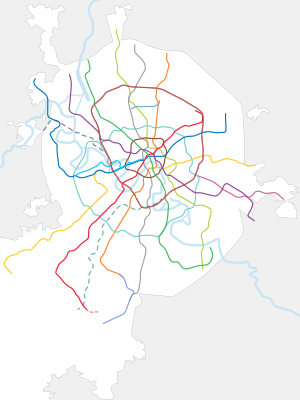


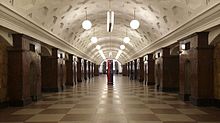

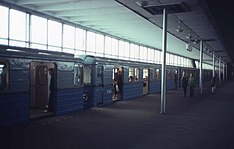

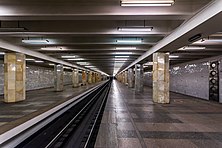


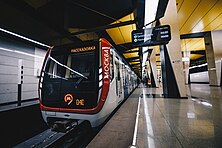


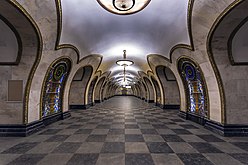
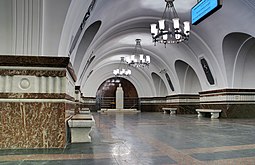




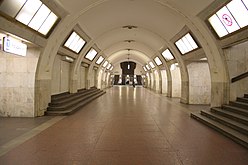
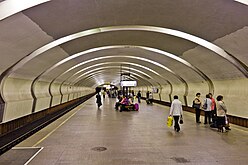


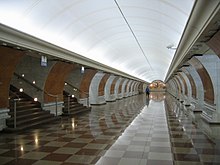
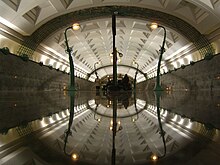

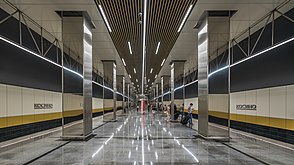

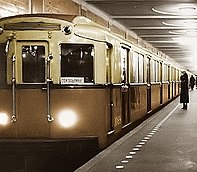


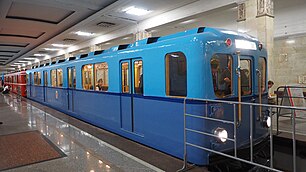





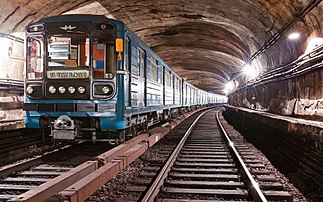
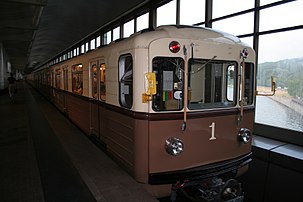
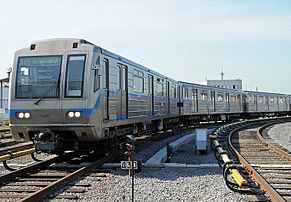
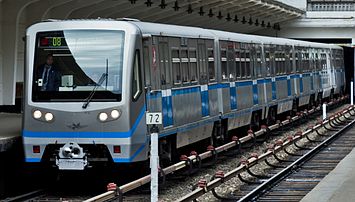

![81-765/766/767-type ("Moscow") [ru]](http://upload.wikimedia.org/wikipedia/commons/thumb/f/ff/81-765-766-767_on_Barrikadnaya_metro_station.jpg/281px-81-765-766-767_on_Barrikadnaya_metro_station.jpg)
